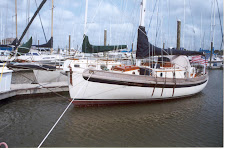If the gaff has only one halyard do you sacrifice some trim capability and run a greater risk of fouling the main when you drop the sail. The throat halyard is for raising sail and the peak halyard for trimming. N'est pa?
With the more traditional two halyard rig you can drop the peak to "scandalize" the main and quickly de-power. I suppose you lose that capability if you have only one gaff halyard?
Just looking at the single halyard's angle of approach it appears there would be more potential for a fouled gaff when you drop the main. I would rather have to handle two halyards than climb the mast to unfoul a jammed gaff. Comments?
Below are excerpts from Mr. Karstan's essay relating specificly to his views on the gaff rig. To read the complete text click here What's the Ideal Sailing Rig?
Is the Gaff Rig Suited to Modern Cruising...?
If windward sailing is of paramount importance then of course the Bermuda rig has much to recommend it.
For modern day cruising the gaff rig is often maligned. In my view, for blue water voyaging the gaff rig has much to offer.
If a vessel's keel is shaped efficiently and if the sails are cut for maximum efficiency on the wind and if the sail plan has been designed well, a gaff rigged boat will perform incredibly well, in many cases besting the performance of




